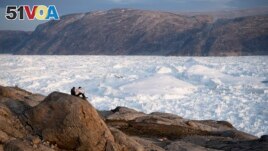An international study says ice in Greenland and Antarctica is melting faster than it was about 30 years ago.
The study used 50 different satellite estimates gathered by the U.S. space agency NASA and the European Space Agency (ESA).
The scientists involved said that the rate of melting increased up to 2020, the last year for which information was available. They also said that the melting has caused a mean rise in the world's sea level of about 21 millimeters.

FILE - In this Aug. 16, 2019 photo, NYU student researchers sit on top of a rock overlooking the Helheim glacier in Greenland.(AP Photo/Felipe Dana)
The study said there was 20 percent more melted ice from Greenland between 2017 to 2020 than from 2012 to 2016. And the melting was more than seven times higher than yearly melting from 1992 to 1996.
The new data "are pretty disastrous really," said study co-writer Ruth Mottram, a climate scientist at the Danish Meteorological Institute. "We're losing more and more ice from Greenland."
The lead writer of the study is Ines Otosaka. She studies glaciers at the University of Leeds in Britain. She said the faster ice loss is clearly a result of human-caused climate change.
Ice in Greenland and Antarctica represents 99 percent of the world's ice on dry land. From 1992 to 1996, the study said, ice in the two areas was melting at a rate of 105 billion metric tons a year. Two-thirds of that amount was in Antarctica.
But from 2017 to 2020, the combined estimated melting increased to 372 billion metric tons a year. More than two-thirds of the melting took place in Greenland, said the study in the journal Earth System Science Data.
Since 1992, Earth has lost 7.6 trillion metric tons of ice from the two ice areas, the study found. That is enough to cover France with 15 meters of water. But because the world's oceans are so huge, the melted ice since 1992 only adds less than 21 millimeters to world sea levels.
Melt from ice sheets previously caused only five percent of sea level rise. Now it causes more than 25 percent of the rise, the study said. The rest of the sea rise comes from warmer water expanding and melting ice from other glaciers.
Although the study showed slower melting in parts of Antarctica, the longer-term data suggests an increasing rate of melting there.
A team of more than 65 scientists regularly calculates ice sheet loss in research funded by NASA and the European Space Agency. The new study adds three more years of data. The researchers used three different methods to measure the melting, Otosaka said.
The techniques include measuring changes in gravity and ice height, along with measuring snow fall and melt. Otosaka added that all the satellites, radar, ground observations and computer models basically say the same thing -- ice sheet melting is accelerating.
"This matters because rising sea levels will displace and/or financially impact hundreds of millions of people, if not billions, and will likely cost trillions of dollars," said Walleed Abdalati, a former NASA scientist and University of Colorado ice researcher. Abdalati was not part of the study.
Seth Borenstein wrote this story for The Associated Press. Andrew Smith adapted it for VOA Learning English.
The story is read one-third slower than normal speaking speed using an artificial intelligence voice generator.
______________________________________________________________
Words in This Story
mean –adj. a value that is exactly in between the highest and lowest number in a set of numbers
glacier –n. a huge area of ice on land that moves slowly because of gravity
